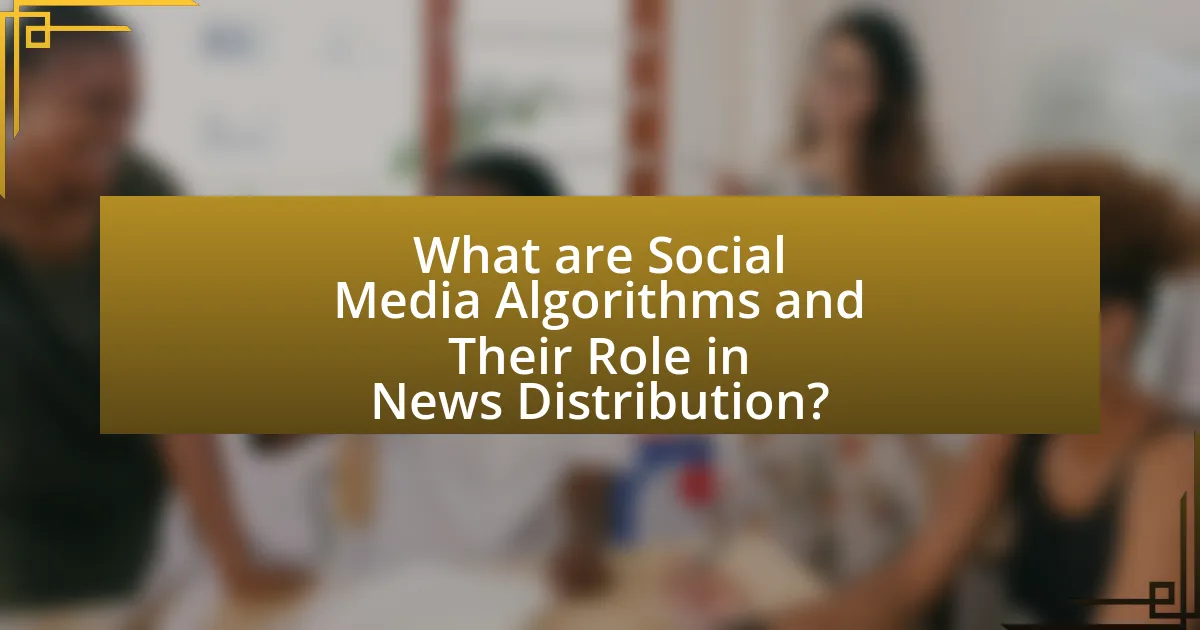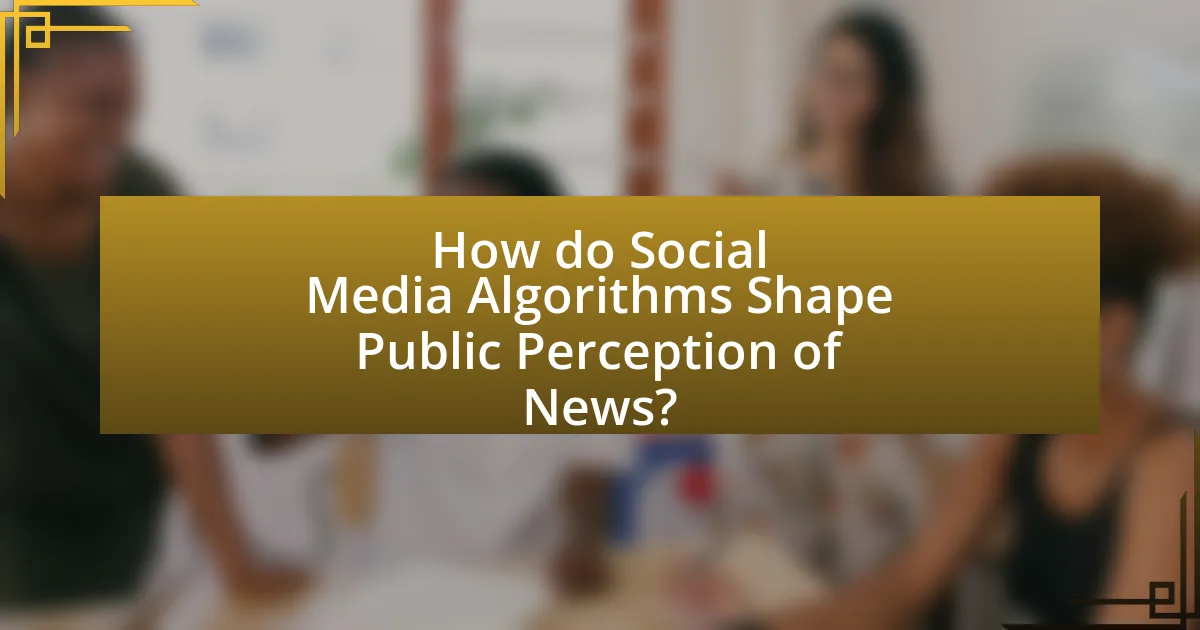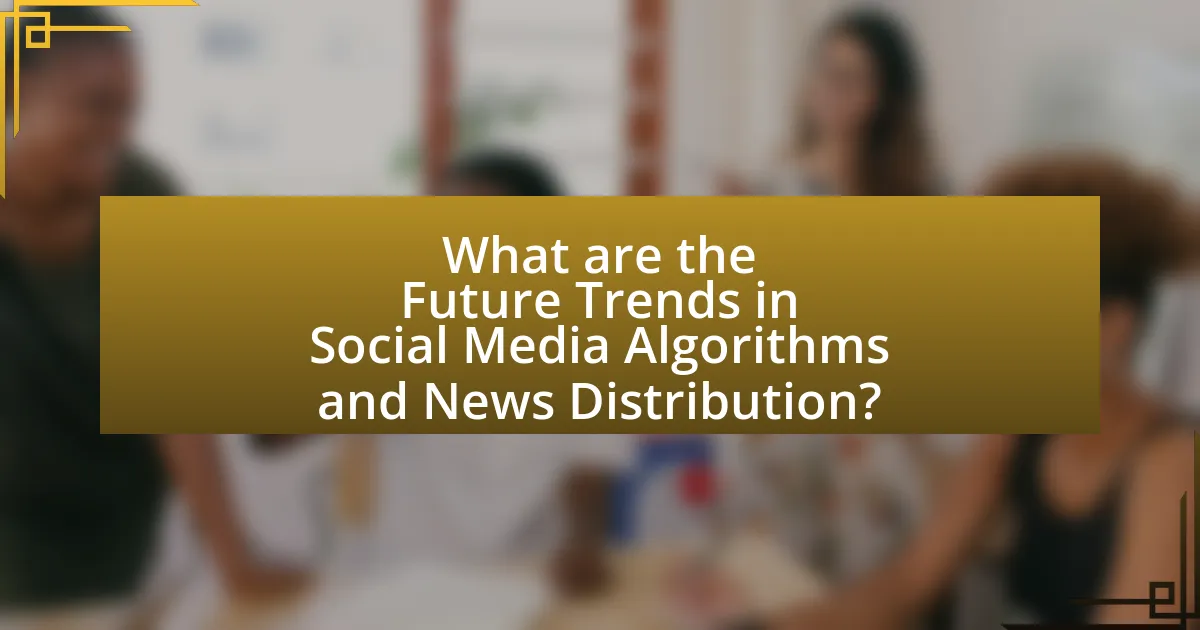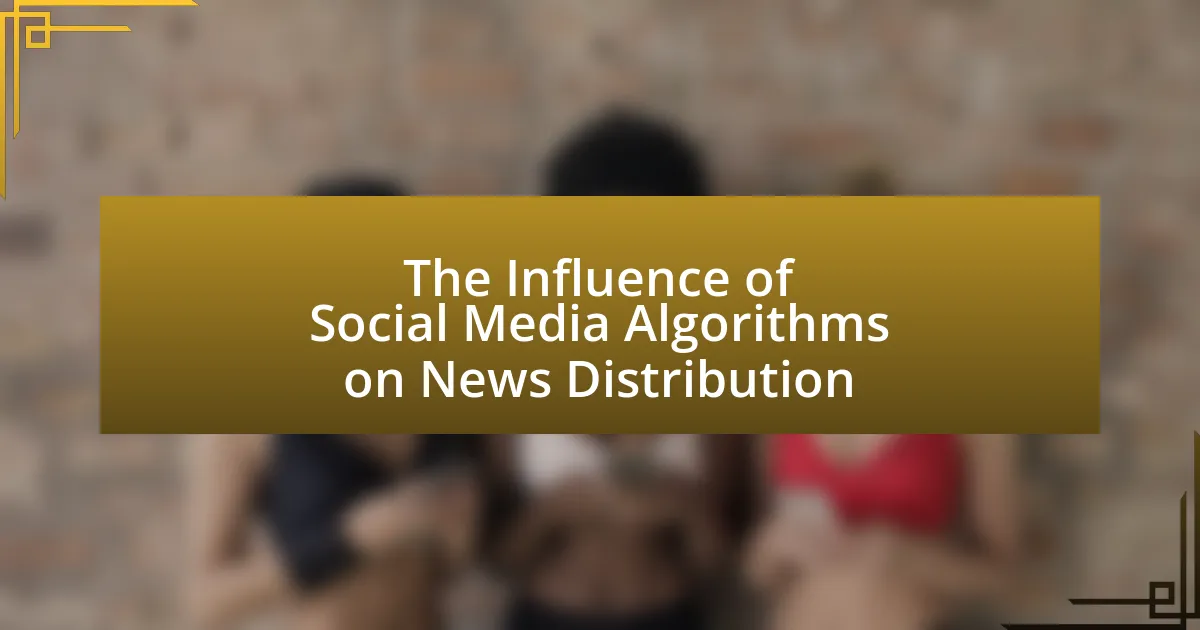Social media algorithms are mathematical formulas employed by platforms such as Facebook, Twitter, and Instagram to curate and prioritize news content based on user behavior and engagement metrics. These algorithms significantly influence the visibility of news articles, shaping public perception and potentially leading to echo chambers where users are primarily exposed to viewpoints that align with their own. The article explores how these algorithms determine news distribution, the factors affecting article ranking, and the implications for news organizations and public discourse. Additionally, it addresses the challenges posed by algorithm changes, the role of artificial intelligence, and best practices for news organizations to navigate this evolving landscape.

What are Social Media Algorithms and Their Role in News Distribution?
Social media algorithms are complex mathematical formulas used by platforms like Facebook, Twitter, and Instagram to determine which content is shown to users. These algorithms analyze user behavior, engagement metrics, and content relevance to prioritize news articles and posts in users’ feeds. For instance, Facebook’s algorithm considers factors such as likes, shares, and comments to decide the visibility of news content, which can significantly influence what information users receive. Research indicates that algorithmic curation can lead to echo chambers, where users are exposed primarily to viewpoints that align with their own, impacting public discourse and information diversity.
How do social media algorithms determine what news is shown to users?
Social media algorithms determine what news is shown to users by analyzing user behavior, preferences, and engagement patterns. These algorithms utilize data such as likes, shares, comments, and time spent on specific content to prioritize news articles that align with individual interests. For instance, Facebook’s algorithm employs machine learning techniques to assess user interactions, which influences the visibility of news stories in a user’s feed. Research indicates that algorithms can significantly shape public perception by amplifying certain narratives while suppressing others, as seen in studies conducted by the Pew Research Center, which highlight the role of algorithmic curation in shaping news consumption.
What factors influence the ranking of news articles in social media feeds?
The ranking of news articles in social media feeds is influenced by several key factors, including user engagement, recency of the content, and relevance to the user’s interests. User engagement metrics, such as likes, shares, and comments, signal to algorithms that the content is valuable, leading to higher visibility. The recency of articles also plays a crucial role, as fresher content is often prioritized to keep feeds current. Additionally, algorithms analyze user behavior and preferences to determine relevance, ensuring that articles align with individual interests. These factors collectively shape the visibility and ranking of news articles in social media environments.
How do user interactions affect news visibility on social media platforms?
User interactions significantly enhance news visibility on social media platforms by influencing algorithmic prioritization. When users engage with news content through likes, shares, and comments, algorithms interpret this as a signal of relevance and popularity, thereby increasing the likelihood of that content being displayed to a broader audience. For instance, Facebook’s algorithm favors posts that generate high engagement, leading to a 50% increase in visibility for content that receives substantial interaction compared to less engaged posts. This dynamic creates a feedback loop where popular news stories gain further visibility, attracting even more interactions.
Why are social media algorithms important for news organizations?
Social media algorithms are crucial for news organizations because they determine how content is prioritized and distributed to users. These algorithms analyze user behavior, engagement, and preferences to curate news feeds, which directly impacts the visibility of news articles. For instance, a study by the Pew Research Center found that 62% of adults get news from social media, highlighting the platform’s role in shaping public discourse. Consequently, news organizations must understand and adapt to these algorithms to ensure their content reaches a wider audience and remains relevant in a competitive digital landscape.
How do algorithms impact the reach of news content?
Algorithms significantly impact the reach of news content by determining which articles are prioritized in users’ feeds. These algorithms analyze user behavior, engagement metrics, and content relevance to curate personalized news experiences. For instance, a study by the Pew Research Center found that 62% of Americans get news from social media, where algorithms play a crucial role in shaping visibility. Consequently, news articles that align with users’ interests or generate higher engagement are more likely to be displayed prominently, while less engaging content may be suppressed, limiting its audience reach.
What challenges do news organizations face due to algorithm changes?
News organizations face significant challenges due to algorithm changes, primarily in audience reach and revenue generation. Algorithm modifications by platforms like Facebook and Google can drastically alter the visibility of news content, leading to decreased traffic to news websites. For instance, a 2018 study by the Pew Research Center found that changes in Facebook’s algorithm reduced referral traffic to news sites by up to 25%. This decline in visibility directly impacts advertising revenue, as fewer readers translate to lower ad impressions and engagement. Additionally, news organizations must adapt their content strategies to align with shifting algorithm preferences, which can strain resources and lead to a focus on sensationalism over quality journalism.

How do Social Media Algorithms Shape Public Perception of News?
Social media algorithms shape public perception of news by prioritizing content that aligns with users’ interests and engagement patterns, often leading to echo chambers. These algorithms analyze user behavior, such as likes, shares, and comments, to curate news feeds that reinforce existing beliefs, which can distort the diversity of information presented. Research from the Pew Research Center indicates that 62% of Americans get news from social media, highlighting the significant role these platforms play in shaping public discourse. Consequently, the selective exposure to news can influence opinions and attitudes, as users are less likely to encounter opposing viewpoints, thereby affecting their overall understanding of current events.
What is the relationship between algorithmic curation and news bias?
Algorithmic curation significantly influences news bias by determining which news stories are prioritized and presented to users based on their preferences and behaviors. This process can lead to the reinforcement of existing biases, as algorithms often favor content that aligns with users’ previous interactions, creating echo chambers. Research by the Pew Research Center indicates that social media users are more likely to encounter news that reflects their political views, which can skew public perception and understanding of issues. Consequently, algorithmic curation not only shapes individual news consumption but also contributes to broader societal biases by limiting exposure to diverse perspectives.
How can algorithms contribute to echo chambers in news consumption?
Algorithms contribute to echo chambers in news consumption by personalizing content based on user preferences and behaviors, which often leads to the reinforcement of existing beliefs. These algorithms analyze user interactions, such as clicks and shares, to curate news feeds that prioritize familiar viewpoints while filtering out diverse perspectives. Research by the Pew Research Center indicates that 62% of social media users encounter news that aligns with their views, which can limit exposure to opposing opinions and create a feedback loop that strengthens ideological divides.
What role does algorithmic transparency play in public trust in news?
Algorithmic transparency significantly enhances public trust in news by allowing audiences to understand how news content is selected and presented. When news organizations disclose the algorithms that influence content distribution, it fosters accountability and reduces perceptions of bias, as users can see the criteria used for news curation. Research indicates that transparency in algorithms can lead to increased user engagement and trust; for instance, a study by the Pew Research Center found that 70% of users are more likely to trust news sources that openly share their content selection processes. This trust is crucial in an era where misinformation is prevalent, as transparent algorithms can help users critically evaluate the information they consume.
How do algorithms affect the diversity of news sources presented to users?
Algorithms significantly reduce the diversity of news sources presented to users by prioritizing content that aligns with their previous interactions and preferences. This personalization often leads to echo chambers, where users are exposed primarily to viewpoints that reinforce their existing beliefs. Research by the Pew Research Center indicates that 62% of social media users encounter news that reflects their own views, limiting exposure to diverse perspectives. Consequently, algorithms can create a skewed information landscape, where a narrow range of sources dominates user feeds, ultimately affecting public discourse and understanding of complex issues.
What are the implications of limited news diversity on public discourse?
Limited news diversity negatively impacts public discourse by restricting the range of viewpoints and information available to the public. This limitation can lead to echo chambers, where individuals are only exposed to opinions that reinforce their existing beliefs, thereby reducing critical thinking and open dialogue. Research indicates that diverse news sources contribute to a more informed citizenry, as seen in studies showing that exposure to varied perspectives enhances understanding of complex issues (Pew Research Center, 2021). Consequently, the lack of news diversity can diminish democratic engagement and hinder societal progress by fostering polarization and misinformation.
How can users mitigate the effects of algorithm-driven news feeds?
Users can mitigate the effects of algorithm-driven news feeds by actively curating their content consumption. This involves following a diverse range of sources, adjusting their feed preferences, and utilizing tools that promote balanced information exposure. Research indicates that individuals who engage with a variety of viewpoints are less likely to fall into echo chambers, which are often reinforced by algorithms favoring similar content. For instance, a study published in the journal “Nature” found that exposure to diverse news sources can significantly reduce polarization in opinions. By consciously selecting different perspectives and employing features like “unfollow” or “mute,” users can counteract the narrow focus of algorithmic recommendations.

What are the Future Trends in Social Media Algorithms and News Distribution?
Future trends in social media algorithms and news distribution include increased personalization, enhanced use of artificial intelligence, and a focus on transparency and ethical considerations. Personalization will leverage user data to tailor news feeds, ensuring that content aligns closely with individual preferences, which has been shown to increase user engagement. The integration of advanced AI technologies will enable platforms to analyze vast amounts of data in real-time, improving the accuracy of content recommendations and potentially reducing the spread of misinformation. Additionally, there is a growing demand for transparency in how algorithms operate, driven by public concern over bias and misinformation; platforms are likely to implement clearer guidelines and disclosures about their algorithmic processes to build user trust. These trends reflect a shift towards more responsible and user-centric approaches in social media news distribution.
How are emerging technologies influencing social media algorithms?
Emerging technologies are significantly influencing social media algorithms by enhancing their ability to analyze user behavior and preferences in real-time. For instance, advancements in machine learning and artificial intelligence allow algorithms to process vast amounts of data, enabling more personalized content delivery. According to a study by the Pew Research Center, 64% of Americans believe that social media platforms have a major impact on the news they see, highlighting the algorithms’ role in shaping information exposure. Additionally, natural language processing techniques improve the algorithms’ understanding of context and sentiment, further refining content recommendations. This technological evolution leads to more targeted advertising and content curation, ultimately affecting how news is distributed and consumed on these platforms.
What role does artificial intelligence play in the evolution of news distribution?
Artificial intelligence significantly enhances the evolution of news distribution by optimizing content delivery and personalizing user experiences. AI algorithms analyze user behavior, preferences, and engagement patterns to curate news feeds that are tailored to individual interests, thereby increasing the relevance of the information presented. For instance, platforms like Facebook and Twitter utilize machine learning to prioritize news articles that align with users’ past interactions, resulting in higher engagement rates. According to a study by the Pew Research Center, 62% of Americans get news from social media, highlighting the critical role AI plays in shaping how news is consumed in the digital age.
How might user privacy concerns shape future algorithm development?
User privacy concerns will significantly influence future algorithm development by prompting companies to prioritize data protection and transparency. As users become increasingly aware of how their data is collected and utilized, regulatory frameworks like the General Data Protection Regulation (GDPR) in Europe will drive algorithm designers to implement privacy-centric features. For instance, algorithms may evolve to minimize data collection, utilize anonymization techniques, and enhance user control over personal information. This shift is already evident, as many tech companies are adopting privacy-by-design principles, which integrate privacy considerations into the development process from the outset. Consequently, algorithms will likely focus on delivering personalized content while ensuring compliance with privacy regulations, ultimately reshaping the landscape of social media news distribution.
What best practices can news organizations adopt to navigate algorithm changes?
News organizations can adopt several best practices to navigate algorithm changes effectively. First, they should diversify their distribution channels beyond social media platforms to reduce dependency on any single algorithm. This includes utilizing email newsletters, podcasts, and their own websites to reach audiences directly.
Second, news organizations should focus on producing high-quality, engaging content that encourages user interaction, as algorithms often prioritize content that generates likes, shares, and comments. Research indicates that content with higher engagement rates tends to perform better in algorithm-driven feeds.
Third, they should stay informed about algorithm updates and trends by following industry news and participating in relevant forums. This proactive approach allows organizations to adapt their strategies in response to changes.
Finally, leveraging data analytics to understand audience preferences and behaviors can help news organizations tailor their content to meet the demands of their audience, thereby improving visibility in algorithmic feeds.
How can news organizations optimize their content for algorithmic visibility?
News organizations can optimize their content for algorithmic visibility by focusing on high-quality, engaging content that aligns with audience interests and platform algorithms. This involves using relevant keywords, creating shareable multimedia elements, and maintaining a consistent posting schedule to enhance engagement metrics. Research indicates that content with higher engagement rates, such as likes, shares, and comments, is favored by algorithms, leading to increased visibility. For instance, a study by the Pew Research Center found that articles with compelling headlines and visuals are more likely to be shared, thus improving their reach on social media platforms.
What strategies can be employed to engage audiences amidst algorithm shifts?
To engage audiences amidst algorithm shifts, content creators should prioritize authentic engagement, diversify content formats, and leverage data analytics. Authentic engagement fosters trust and loyalty, as audiences are more likely to interact with genuine content rather than algorithm-driven posts. Diversifying content formats, such as incorporating videos, polls, and interactive stories, caters to varying audience preferences and can enhance visibility despite algorithm changes. Utilizing data analytics allows creators to understand audience behavior and preferences, enabling them to tailor content effectively. Research indicates that platforms like Instagram and Facebook have seen increased engagement rates when users employ varied content strategies, demonstrating the effectiveness of these approaches in adapting to algorithm shifts.

Leave a Reply